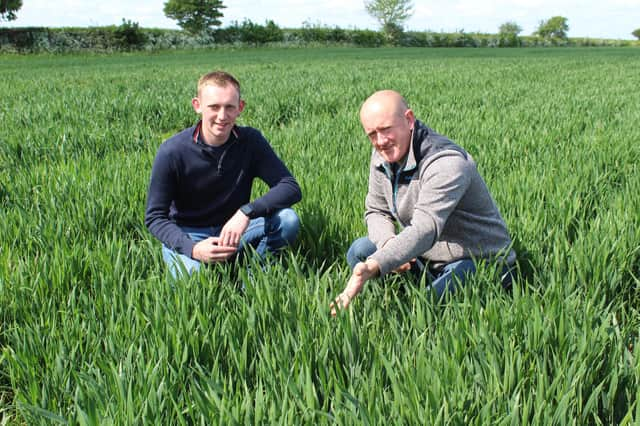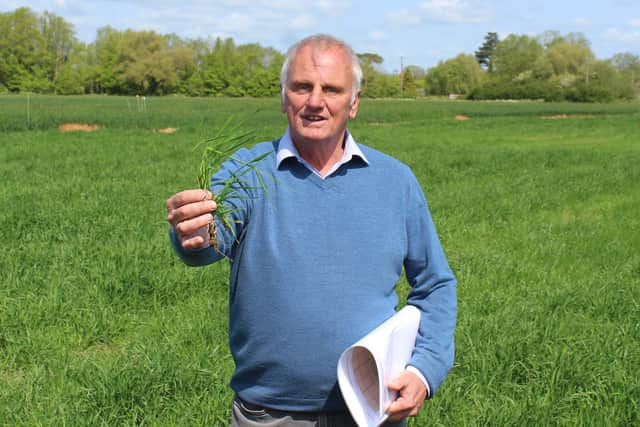Blackgrass is symbolic of the ‘resistant weed’ threat now confronting the arable sector


And one weed in particular- blackgrass - is symbolic of this challenge. Thankfully, it is not widely found across the island of Ireland at this stage.
But the weed now represents a major challenge to arable farmers in many parts of England. It is now, more or less, totally resistant to all selective herbicides.
Advertisement
Advertisement
The need to keep blackgrass out of Northern Ireland is obvious.


However, the future management of the weed within crop rotations is of more than significant interest to local cereal growers.
Hence, the relevance of the blackgrass trials, which are now taking place at Stow Longa in Cambridgeshire.
The projects have been developed and managed by agronomists with the Agrii organisation.
Advertisement
Advertisement
The work has one, overriding objective: to develop rotation and cultivation-based techniques as a means of controlling herbicide-resistant grass weeds.
This list includes blackgrass, bromes and ryegrasses.
The trial work to date has identified a number of factors that will impact on blackgrass plant numbers.
These include: planting date, the rotations followed and min-till versus ploughing.
But driving all of this is a fundamental knowledge of the soil that is actually being worked.
Advertisement
Advertisement
At the Stow Longa site the non-organic fraction of the soils have a 51% silt content.
This is an extremely mobile component within any profile and plays a key role in developing soil pans if zero or min-till cultivation options are practised on a consistent basis.
The work at Stow Longa has been supported by Lemken from the get-go with the results generated from the work used by the company to develop its own views on the future of tillage machinery design.
Lemken has also been to the fore in communicating the results of the trials to Irish tillage farmers.
Advertisement
Advertisement
Blackgrass is now endemic in many parts of England. Plant numbers in excess of 200/ha can reduce overall cereal yields by up two 2t/ha.
The Stow Longa work has consistently confirmed the impact of planting date on blackgrass control.
Where winter cereals are concerned, delaying drilling dates into October provides growers with the opportunity to maximise the control of autumn germinating blackgrass plants.
The inclusion of spring cereals within a cropping rotation is another factor that helps to drive down blackgrass populations.
Advertisement
Advertisement
The Stow Longa trials have included the use of spring oats and spring barley in this context.
Significantly, oats have proven to be the better option under the soil conditions and climatic that prevail in the east of England.
Driving all of this is the fact that growers going in with a spring crop have the opportunity to control blackgrass plants that have germinated over a six month period.
Significantly, hybrid barleys also perform well under high blackgrass pressure.
Advertisement
Advertisement
The work at Strow Longa has consistently confirmed that this winter cereal option can out-compete the weed under most growing conditions.
It is worth noting that the 2023 hybrid barley plots stand out above all the other crop options, in terms of their yield potential.
But the big question, from a cultivation point of view, comes down to the following choice: the plough or some form of min-till option.
The results achieved to date indicate that continuous min or zero-till does very little to aid the control of blackgrass.
Advertisement
Advertisement
However, coming in with the plough after five years acts as a re-set button.
The highest yields and greatest margins generated at Stow Longa have been consistently achieved from crops that were established using a plough-based system, following a period of min-till.
The crop margins generated by the Agrii trials also confirm the tremendous impact that heavy infestations of blackgrass can have on final crop financials. In 2022, the range in overall gross margins came in at £1,821/ha.
Last year saw winter beans, established using a min-till system, generate the poorest gross margins of all the crops included in the current blackgrass trials.
Advertisement
Advertisement
The Stow Longa site is sub divided into six, one hectare blocks.
In addition, all the trials have confirmed the absolute necessity of producing a firm seed bed, one that maximised the amount of contact between the applied seed and the soil.
Only in this way is the crop guaranteed to get off to the best possible start.
Meanwhile, Teagass is confirming the presence of blackgrass on Irish farms where the problem weed has not been identified up to this point.
Advertisement
Advertisement
This is an extremely worrying development, one which all arable farmers should take a clear note of.
Teagasc tillage specialist Ciaran Collins commented: “The presence of blackgrass needs to be taken very seriously and all methods, including crop destruction, should be employed to eliminate all plants before seed is shed.
“A single plant can produce 1,000 seeds, but this can be as high as 6,000 seeds in the absence of competition.”
He added: “Herbicide resistance is widespread, so relying on herbicides is not an option. Where the population is low, roguing is an option.
Advertisement
Advertisement
“However, a follow up will be required in a few weeks as all plants won’t be visible yet.
“If the population is high or there are bad patches in the field, it may not be practical to rogue, so in these cases crop destruction with glyphosate is the best option.
"Whole cropping may also be an option if a market exists.”
According to Ciaran Collins, farmers must commit to using different herbicide strategies each year, if they want to prevent weed resistance becoming an issue on their farms.
He added: “The most obvious way of developing a herbicide resistance problem is for farmers to use the same chemicals, year-in: year-out.”
Advertisement
Advertisement
The reality is that herbicide resistance is becoming a major issue on arable farms throughout the island of Irland.
For the most part, this problem can be traced back to growers using below recommended herbicide application rates in the past, as a means of saving money.
Teagasc conducted a nationwide survey, looking at the grass weed challenge on cereal farms during the 2020/2021 growing season.
The study included 62 growers with plough-based tillage and 41 with non-inversion tillage from the main tillage areas.
Advertisement
Advertisement
The results of the survey were made public earlier this year.
Bromes were identified on 62% of businesses surveyed. On 56% of the participating farms, spring wild oats were the most prevalent grassland.
In addition, 8% of the bromes analysed were resistant to acetolactate synthase (ALS) type herbicides that would normally be used for control.
It was found that 10% of the wild oat populations sampled were resistant to the commonly used acetyl coA carboxylase (ACCase) herbicide types.
Advertisement
Advertisement
Italian ryegrass and blackgrass weeds were found on fewer farms.
However, the proportion of these weeds with higher resistance risks was much higher, relative to other grasses: 56% in the case of Italian ryegrass and 43%, where blackgrass populations were resistant to ACCase and/or ALS herbicides.
The survey also confirmed that 85% of those growers using non-inversion tillage used crop rotation, compared to about 56% of those who ploughed. Herbicide usage was similar in both systems.
However, in spite of greater adoption of integrated weed management (IWM) practices, non-inversion tillage farms had significantly higher populations of bromes and Italian ryegrass, compared to those farms that ploughed.
Advertisement
Advertisement
This is the first multi-component survey to be carried out in Ireland.
It specifically explored the amount and type of grass weeds that occur in tillage fields, herbicide resistance and integrated weed management (IWM) used, across farms with different crop establishment systems.
The results indicate that grass-weed challenges are on the rise.
Specifically, there are increasing cases of blackgrass and Italian ryegrass resistance to herbicides now being identified in Ireland.
Advertisement
Advertisement
Moreover, the apparent speed at which resistance is developing in both these species, pose a significant threat to crop production
Non-inversion tillage particularly when coupled with earlier sowing increases the grass-weed threat.
As a consequence, there is a need to develop effective cultural/non-chemical weed control tactics to protect existing effective herbicides.
But such is the threat posed by blackgrass that The Irish Seed Trade Association (ISTA) has formally requested its addition to Ireland’s register of noxious weeds.
Advertisement
Advertisement
The issue was first raised by ISTA at a meeting with farm minister Charlie McConalogue last autumn.
By taking this approach, it is hoped that the issue of blackgrass resistance will be more widely profiled.
In addition, Department of Agriculture inspectors have the power to inspect land that is heavily infested with noxious weeds and enforce their destruction.
ISTA represents multipliers and assemblers of Irish certified seed. A spokesperson for the association commented: “We work with growers under contract to submit crops for certification by the seed certification division of The Department of Agriculture.
Advertisement
Advertisement
“Irish cereal seed adheres to a higher voluntary standard than current EU legislation requires and has a zero tolerance to blackgrass.
“This highlights the threat that blackgrass poses to the seed and of course wider tillage industry.”
According to ISTA, a total of eight incidences of blackgrass occurred in crops submitted for certification in 2022.
All of these crops were rejected outright, as per the ISTA voluntary standard.
There were no incidences in 2021 and only two in 2020.
Advertisement
Advertisement
The ISTA representative continued: “The 2022 increase merited immediate action by all involved.
" These crops have been lost to the industry from grower right up the line and will require a commitment, investment and change of cropping and practice to get the weed under control on these lands.
“Blackgrass cannot currently be effectively controlled by plant protection products in a crop.”
Several incidences of blackgrass in commercial crops have been identified this year by agronomists.
Advertisement
Advertisement
Making blackgrass a noxious weed will serve to increase much needed awareness among tillage farmers and others.
It will also give power to DAFM officials to enter on land to confirm presence of or order destruction of the plants or sections of affected crops should it be necessary.
As a further measure, ISTA members have committed to a higher voluntary standard (HVS) with regard to the assembling and certification or importing of straights and mixes for cover crops, wild bird measures and arable margins.
This HVS is a further example of the Irish Seed Trade’s commitment to play its part in the control of grass weeds.
Advertisement
Advertisement
The vast majority of seeds (straights) for cover crops, wild bird measures and other arable margins are imported. Where possible, ISTA members will use Irish certified seed.
ISTA members assembling or importing cover crop mixes or straights will now have each seed lot tested.
This is an internationally-recognised ‘Orange Certificate’ for presentation to department of agriculture officials, ahead of sale or certification in the Republic of Ireland.
The official search will include blackgrass, wild oats and sterile brome.
Only ingredient lots with zero blackgrass test results assembled or imported by ISTA members will be used in mixtures for sale to Irish farmers.